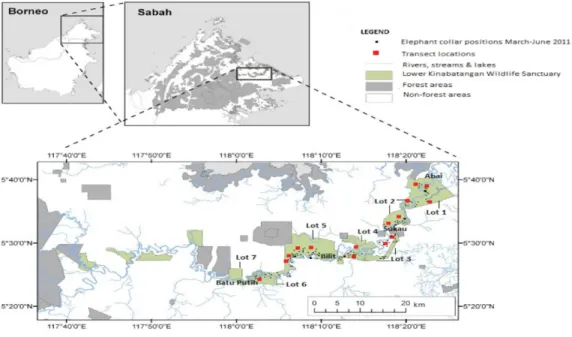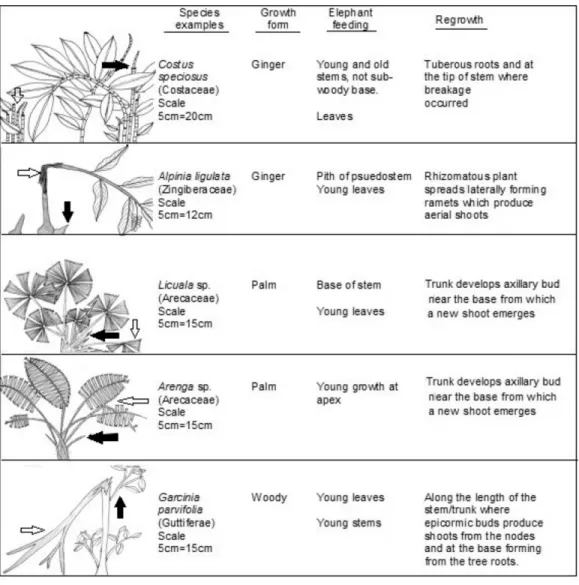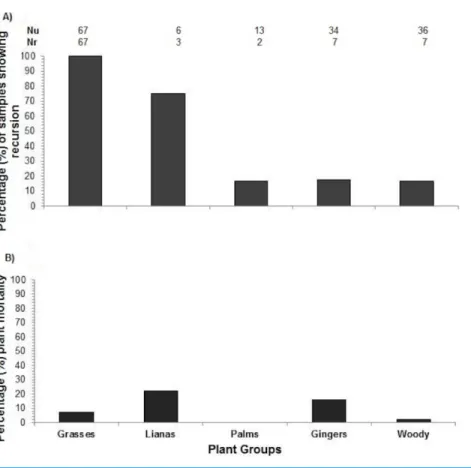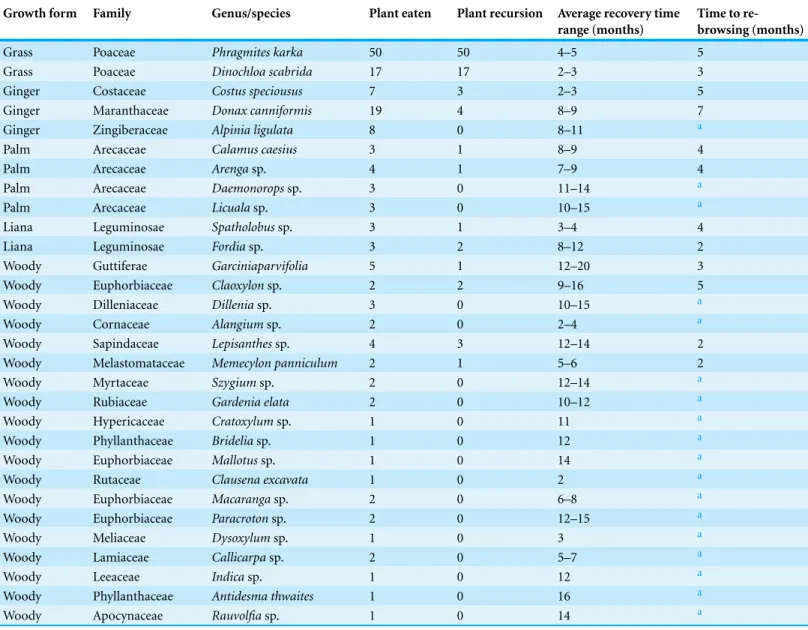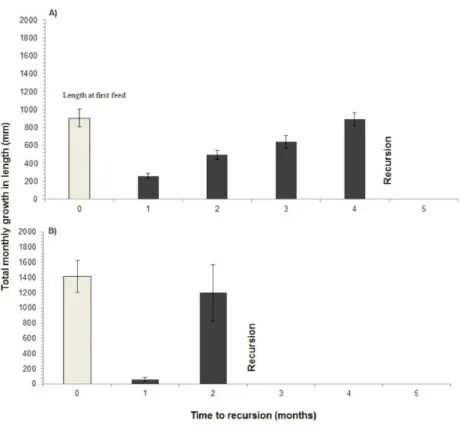Submitted 4 March 2015 Accepted 26 May 2015 Published4 August 2015
Corresponding author
Megan English,
megs.english@gmail.com
Academic editor
Richard Cowling
Additional Information and Declarations can be found on page 12
DOI10.7717/peerj.1030
Copyright
2015 English et al.
Distributed under
Creative Commons CC-BY 4.0
OPEN ACCESS
Recursion to food plants by free-ranging
Bornean elephant
Megan English1, Graeme Gillespie2, Benoit Goossens3,4,5, Sulaiman Ismail6, Marc Ancrenaz6and Wayne Linklater1,7 1Centre for Biodiversity and Restoration Ecology, School of Biological Sciences,
Victoria University of Wellington, New Zealand
2Department of Zoology, University of Melbourne, Parkville, Victoria, Australia
3Danau Girang Field Centre, c/o Sabah Wildlife Department, Kota Kinabalu, Sabah, Malaysia 4Organisms and Environment Division School of Biosciences, CardiffUniversity, Cardiff, UK 5Sabah Wildlife Department, Kota Kinabalu, Sabah, Malaysia
6HUTAN Elephant Conservation Unit and Kinabatangan Orangutan Conservation Project,
Sukau Sabah, Malaysia
7Centre for African Conservation Ecology, Nelson Mandela Metropolitan University,
Port Elizabeth, South Africa
ABSTRACT
Plant recovery rates after herbivory are thought to be a key factor driving recursion by herbivores to sites and plants to optimise resource-use but have not been investigated as an explanation for recursion in large herbivores. We investigated the relationship between plant recovery and recursion by elephants (Elephas maximus borneensis) in the Lower Kinabatangan Wildlife Sanctuary, Sabah. We identified 182 recently eaten food plants, from 30 species, along 14×50 m transects and measured their recovery growth each month over nine months or until they were re-browsed by elephants. The monthly growth in leaf and branch or shoot length for each plant was used to calculate the time required (months) for each species to recover to its pre-eaten length. Elephant returned to all but two transects with 10 eaten plants, a further 26 plants died leaving 146 plants that could be re-eaten. Recursion occurred to 58% of all plants and 12 of the 30 species. Seventy-seven percent of the re-eaten plants were grasses. Recovery times to all plants varied from two to twenty months depending on the species. Recursion to all grasses coincided with plant recovery whereas recursion to most browsed plants occurred four to twelve months before they had recovered to their previous length. The small sample size of many browsed plants that received recursion and uneven plant species distribution across transects limits our ability to generalise for most browsed species but a prominent pattern in plant-scale recursion did emerge. Plant recovery time was a good predictor of time to recursion but varied as a function of growth form (grass, ginger, palm, liana and woody) and differences between sites. Time to plant recursion coincided with plant recovery time for the elephant’s preferred food, grasses, and perhaps also gingers, but not the other browsed species. Elephants are bulk feeders so it is likely that they time their returns to bulk feed on these grass species when quantities have recovered sufficiently to meet their intake requirements. The implications for habitat and elephant management are discussed.
Subjects Animal Behavior, Biodiversity, Ecology, Ecosystem Science, Environmental Sciences
INTRODUCTION
Recursion by wild herbivores is the repeated use of the same sites or finer-scale reuse of resources, such as individual plants, within a site over time. Importantly, recursion by wild herbivores to previously browsed or grazed sites and plants is thought to facilitate plant productivity (re-growth) and its consumption at stages of highest productivity (McNaughton, 1985;Gordon & Lindsay, 1990;English et al., 2014a). Recursion may also accelerate nutrient cycling at sites (Gordon & Lindsay, 1990;McNaughton, Banyikwa & McNaughton, 1997) and so maintain them as nutrient hotspots (Winnie, Cross & Getz, 2008). Thus, recursion is thought to trigger and maintain the positive feedback between large herbivore feeding, and vegetation regeneration and palatability (McNaughton, Banyikwa & McNaughton, 1997). Although recursion is consistent in these ways with optimal-foraging theory and strategies, and assumed to be ubiquitous (McNaughton, 1985), it has only rarely and recently been investigated amongst wild herbivores.
Recursion has been described at site and landscape scales for wild buffalo (Syncerus caffer;Bar-David et al., 2009;Benhamou & Riotte-Lambert, 2012) and impala (Aepyceros melampus;Riotte-Lambert, Benhamou & Chamaille-Jammes, 2013) but finer-scale recursion to individual plants has not been investigated. Nevertheless, recursion has been explored amongst nectivorous insects and birds where the reuse of individual plants was found to occur after nectar replenishment (Davies & Houston, 1981;Bell, 1990;Williams & Thomson, 1998). Recursion behaviour has also been described in frugivorous primates returning to the same trees for fruit (Garber, 1988;Garber & Jelinek, 2006;Erhart & Overdorff, 2008;Janmaat, Ban & Boesch, 2013;Porter & Garber, 2013). As for nectar and fruit feeders, plant recovery period is also expected to strongly influence the movements and recursion frequency (rate) of grazers and browsers amongst sites. Prior to this study, the expected correspondence between individual plant recovery and recursion by wild grazers or browsers as an explanation for site recursion has not been explored.
Recursion patterns may also be a useful indicator of population relations with habitat. Large herbivores, like elephants, are a particularly interesting species in which to study recursion as they are ecosystem engineers—having complex, scale-dependent effects on habitat structure and vegetative community (Bond, 1993;Jones, Lawton & Shachak, 1996). A study of recursion at the individual plant scale can identify if elephants are potentially over-utilising and depleting resources by re-browsing plants before they have recovered, or if they are facilitating growth of preferred or bulk-food plants (Fornara & du Toit, 2007;Cromsigt & Kuijper, 2011). Thus, increases in rates of recursion that exceed plant recovery rates could indicate that a population exceeds habitat capacity and reveal how they are influencing vegetation community structure and composition. Alternatively, plant recovery rates that exceed recursion may be evidence of further capacity to support greater elephant densities. An understanding of recursion patterns, therefore, may augment evaluations of a habitat’s capacity to support elephant and vegetation dynamics on the landscape under elephant grazing and browsing regimes.
In a previous study,English et al. (2014a)showed patterns of elephant recursion to sites consistent with site quality and optimal foraging theory. In this study we aim to test the hypothesis that recursion by elephants to sites in tropical rainforest also involves recursion to individual plants and corresponds with their plant recovery. We predict that elephant recursion would coincide with plant recovery and help to explain the periodicity of site recursion observed previously.
MATERIALS AND METHODS
Study site and focal speciesThe dominant landform of the Lower Kinabatangan region is the extensive floodplain and its swamps. Soils are predominantly alluvial and derived from sedimentary deposits often rich in magnesium. Beyond the floodplains, soils are derived from sedimentary rocks (Azmi, 1998). The Kinabatangan floodplain is characterized by a warm, wet and humid tropical climate. The larger temperature variations are diurnal rather than seasonal. Mean monthly temperatures range between 21◦C and 34◦C (Ancrenaz, Calaque &
Lackman-Ancrenaz, 2004). The north-easterly monsoon brings high monthly rainfall from October to February, although rainfall is also common from March to September. Dry months, with mean monthly rainfall<60 mm, tend to occur at roughly 3-year intervals.
The mean annual rainfall is 3,000 mm (Acres & Folland, 1975).
Figure 1 Map of study site.The Lower Kinabatangan Wildlife Sanctuary, Sabah, Malaysia (English et al., 2014b). Adapted from Clouded Leopard Project, Sabahwww.cloudedleopard.org.
Plant recursion
Fourteen 50 m transects were located where elephants had fed previously. Transects were
>300 m apart. One transect was established per day. We tracked fresh elephant signs
Figure 2 Typological examples of plant growth forms. Examples of plants selected by elephants in LKWS showing plant growth forms and their recovery. White arrows indicate portions of the plant eaten by elephant and black arrows indicate recovery growth.
difficulty in identifying feeding signs (i.e., the whole plant is often ingested) and measuring recovery growth related to feeding by elephants. Student’s T-tests were used to compare the lengths of the individual plant new growth with their lengths when first selected for feeding to determine any significant difference.
Plant recovery growth and recursion rate
The expected time required for each individual plant to recover was estimated by averaging the monthly growth in length (mm) of the plant, divided by its estimated length at the beginning of study which was based on what remained of the stem after elephant feeding. Other stems on the same plant were used as a surrogate reference. Based on this monthly growth average, we estimated how many months it would take for the individual plant to return to its previous length. The difference in the average recovery time (months) subtracted from the average recursion time (months) is shown for each growth form (grass, ginger, palm, liana and woody species) where the plant species are the replicates used to derive standard errors for each growth form.
Multi-model inference and selection
An information theoretic approach (linear mixed effects model) was applied to test the hypothesis for recursion time and plant recovery time. Individual plant recovery times and time to recursion were used in the statistical analysis. We predicted recursion would occur after individual plants had recovered to their pre-herbivory height. We evaluated the power of plant recovery to explain recursion in the absence of othera priorihypotheses by comparing a model of our hypothesis with models that included random effects for site (transect) and growth form. We described and evaluated models in the ‘lme4’ package in R (Bates et al., 2014). All plants browsed by elephants, including those plants that did not receive recursion but were located on transects that received recursion, were included in the analyses. We used maximum likelihood (MLE) to provide estimates of the model’s parameters because fixed effects were different between models.
RESULTS
Individual food plants, recently eaten by elephants, were identified by following the herd that was allowed to select sites and plants without influence. As one would expect for a herbivore selecting from a diverse landscape and flora we identified many individuals of commonly eaten species but a larger number of species represented by a few individuals. Thus, our sampling is skewed towards a few commonly eaten plants with many other species being eaten little by elephants and sampled less.
Figure 3 Plant recursion and plant mortality.(A) The percentage of plants along transects re-browsed by elephants.Nu, number of plants of each plant group eaten by elephants at the first visit;Nr, number of plants of each plant group that were re-browsed. (B) Plant mortality within plant growth forms.
The time to recursion for each plant species varied across the nine months of sampling (Table 1). Four species including ginger:Costus speciousus, grasses: Dinochloa scabrida, Phragmites karkaand liana:Spatholobus sp., had recovered to their previous size when they were re-browsed, whereas the remaining eight species were re-browsed before they had fully recovered (Figs. 4and5). Seventy-seven percent of re-browsed plants were grasses. A linear mixed-effects model found that the plant recovery time is a good predictor of time to recursion but this varies as a function of growth form (grass, ginger, palm, liana and woody) and differences between sites. A large amount of variation is unexplained by recovery time (Table 2).
Two species of grass,Phragmites karka—a reed, andDinochloa scabrida—a bamboo, received recursion at a time when their length was not significantly different from when they had first been selected (Reed:t-test , df=50,P=0.137; Bamboo:t-test , df=17,P=
0.232) (Fig. 4). However all other growth forms that were selected were re-browsed before
Table 1 Elephant food plants and recursion.Plant genus/species eaten by elephants and those re-browsed at recursion during the 9-month study period. The number of plants eaten, number returned to, average time to plant species recovery and time to re-browsing at recursion are shown.
Growth form Family Genus/species Plant eaten Plant recursion Average recovery time
range (months)
Time to re-browsing (months)
Grass Poaceae Phragmites karka 50 50 4–5 5
Grass Poaceae Dinochloa scabrida 17 17 2–3 3
Ginger Costaceae Costus speciousus 7 3 2–3 5
Ginger Maranthaceae Donax canniformis 19 4 8–9 7
Ginger Zingiberaceae Alpinia ligulata 8 0 8–11 a
Palm Arecaceae Calamus caesius 3 1 8–9 4
Palm Arecaceae Arengasp. 4 1 7–9 4
Palm Arecaceae Daemonoropssp. 3 0 11–14 a
Palm Arecaceae Licualasp. 3 0 10–15 a
Liana Leguminosae Spatholobussp. 3 1 3–4 4
Liana Leguminosae Fordiasp. 3 2 8–12 2
Woody Guttiferae Garciniaparvifolia 5 1 12–20 3
Woody Euphorbiaceae Claoxylonsp. 2 2 9–16 5
Woody Dilleniaceae Dilleniasp. 3 0 10–15 a
Woody Cornaceae Alangiumsp. 2 0 2–4 a
Woody Sapindaceae Lepisanthessp. 4 3 12–14 2
Woody Melastomataceae Memecylon panniculum 2 1 5–6 2
Woody Myrtaceae Szygiumsp. 2 0 12–14 a
Woody Rubiaceae Gardenia elata 2 0 10–12 a
Woody Hypericaceae Cratoxylumsp. 1 0 11 a
Woody Phyllanthaceae Brideliasp. 1 0 12 a
Woody Euphorbiaceae Mallotussp. 1 0 14 a
Woody Rutaceae Clausena excavata 1 0 2 a
Woody Euphorbiaceae Macarangasp. 2 0 6–8 a
Woody Euphorbiaceae Paracrotonsp. 2 0 12–15 a
Woody Meliaceae Dysoxylumsp. 1 0 3 a
Woody Lamiaceae Callicarpasp. 2 0 5–7 a
Woody Leeaceae Indicasp. 1 0 12 a
Woody Phyllanthaceae Antidesma thwaites 1 0 16 a
Woody Apocynaceae Rauvolfiasp. 1 0 14 a
Notes.
aRepresents plant species that did not receive recursion.
DISCUSSION
Figure 4 Recursion to grasses.Recursion to grasses showing the average length of the grass stem when initially fed on (shaded bar) and the average total length of new shoots per month until recursion occurred, for two grass species (A)Phragmites karkaand (B)Dinochloa scabrida. Standard error bars represent±1 standard deviation of the sample distribution. Recovery has occurred when the black bar is the same length as the white bar.
Table 2 Multimodel inference and selection.Four models ranked in order of AIC weights where recov-ery time (months) is the fixed-effect and plant growth form and site are random-effects, the response variable is time to recursion (months).
Model Fixed effects Random effects n K AICc ΔAIC ω
1 Recovery time Growth form & site ID 146 4 561.9 0 0.6300
2 (Base model) Growth form & site ID 146 3 563.2 1.3 0.3300
3 Recovery time Growth form 146 3 567.1 5.2 0.0500
4 Recovery time Site ID 146 3 612.1 50.2 0.0000
The large amount of variation attributable to sites may pertain to a number of abiotic influences on plant recovery rates, such as soil fertility and micro-climate.
Recursion rate corresponded best with the recovery of grasses:Dinochloa scabridaand
Phragmites karka, even though those grass species had very different recovery times: e.g., 2–3 and 4–5 months, respectively. In all cases these grazed plants were returned to after they had recovered. Grasses have also been identified as the preferred food plants of the elephants (English et al., 2014b) and they made up 43% of all plants selected and 77% of plants receiving recursion. Elephants are bulk feeders so it is likely that they time their returns to bulk feed on grasses and grassed sites when stands have recovered sufficiently to meet their intake requirements. Grasses were less likely to die and faster to recover compared to other growth forms. Other than grasses, most species did not receive recursion, or if they did, it occurred before the individual plants had recovered.
Recursion to a few poorly regenerated species, specifically woody trees, palms, lianas and one species of ginger, may be a result of elephants foraging on other nearby plants (i.e., grasses) and indiscriminately re-browsing those unrecovered plants. If this was the case we would expect the re-browsing of plants prior to their recovery would be most com-mon when they are found within grass-dominated sites. Half of the browse plant samples found within grass-dominated sites were re-browsed before their recovery compared to 20% of those outside grassed areas. Thus, premature woody-plant re-browsing could be an ancillary to grazing sites.
lead to the creation and maintenance of open, grassed areas. These areas are likely to become dominated by early successional species, thus providing the elephants with more of their preferred food such as grasses. Therefore, feeding on woody species faster than they can recover may augment grass patches and prevent woody invasion. This is a common observation of elephants. As ecosystem engineers they are known to alter the structure and composition of habitat and plant communities (Laws, 1970;Bryant, 1981;Bergstr¨om & Danell, 1987;du Toit, Bryant & Frisby, 1990;Ben-Shahar, 1993;Prins et al., 1998). Elephant impact on woody vegetation has led to decreasing numbers of trees and increase of open areas in Africa (Conybeare, 2004;O’Connor, Goodman & Clegg, 2007). The results of our study suggest that elephants in LKWS may be controlling re-forestation within open grass areas by re-browsing on woody species, lianas, and palms before their recovery. However, a long-term study on elephants as ecosystem engineers within the Lower Kinabatangan is required.
Another plausible explanation for recursion on poorly regenerated plants is that these plants are highly desirable and resources in the area are inadequate, perhaps due to spatial constraints, habitat fragmentation and overstocking. Resources may be insufficient to support a slower site recursion rate. Elephant feeding on plants before they have recovered might indicate that food species are being over-exploited and that the elephant population is approaching or exceeding habitat carrying capacity. However, with the exception of grasses, our results show that only 19 of 89 browse plants were returned to for feeding during the nine-month study period. This finding suggests that there is no evidence from recursion data that this elephant population has exceeded the area’s carrying capacity. The two first explanations, individually or in combination, best explain the pattern.
Limitations in data collection in this study are imposed by the lack of independence between plant samples within species and amongst sites that were determined by elephant movements and choices and also due to plant distributions within the study area, particularly for Poaceae, which occur in homogenous stands at just a few sites that are highly favoured by the elephant (English et al., 2014b). Sites and transects are not balanced replicates for each plant species measured, and recursion occurred to most but not all selected sites. A lack of equal distribution of all species across all transects due to elephant food plant choices and plant species heterogeneity and distribution influenced the strength of the data. Moreover, despite a satisfactory sample size of browsed plants initially, a lack of re-browsing to plant samples across a variety of species resulted in reduced sample sizes of plants receiving recursion, especially for woody species, and therefore limited statistical power.
all transects and increasing sample sizes of each species. For example, by establishing more transects or extending sampling distance (>2 m either side of transect) in order to
incorporate a larger number of samples within each species for statistical comparison. It would also be beneficial to compare inter-annual variation in re-browsing and elephant impact on their resources as ecosystem engineers.
ADDITIONAL INFORMATION AND DECLARATIONS
Funding
This project was funded by ZoosVictoria, Australia, and research scholarships provided by Victoria University of Wellington, New Zealand. The funders had no role in study design, data collection and analysis, decision to publish, or preparation of the manuscript.
Grant Disclosures
The following grant information was disclosed by the authors: ZoosVictoria, Australia.
Victoria University of Wellington.
Competing Interests
The authors declare there are no competing interests.
Author Contributions
• Megan English conceived and designed the experiments, performed the experiments, analyzed the data, contributed reagents/materials/analysis tools, wrote the paper, prepared figures and/or tables, reviewed drafts of the paper.
• Graeme Gillespie conceived and designed the experiments, contributed reagents/ materials/analysis tools, prepared figures and/or tables, reviewed drafts of the paper. • Benoit Goossens and Marc Ancrenaz contributed reagents/materials/analysis tools,
reviewed drafts of the paper.
• Sulaiman Ismail performed the experiments, contributed reagents/materials/analysis tools.
• Wayne Linklater conceived and designed the experiments, analyzed the data, con-tributed reagents/materials/analysis tools, wrote the paper, prepared figures and/or tables, reviewed drafts of the paper.
Animal Ethics
The following information was supplied relating to ethical approvals (i.e., approving body and any reference numbers):
Field Study Permissions
The following information was supplied relating to field study approvals (i.e., approving body and any reference numbers):
Economic Planning Unit, Kuala Lumpur and Sabah Wildlife Department. Research pass number: 2833.
Supplemental Information
Supplemental information for this article can be found online athttp://dx.doi.org/ 10.7717/peerj.1030#supplemental-information.
REFERENCES
Acres BD, Folland CJ. 1975.The soils of the Sabah: Sandakan and Kinabatangan districts. Land Resources Division, Directorate of Overseas Surveys.
Ancrenaz M, Calaque R, Lackman-Ancrenaz I. 2004.Orangutan nesting behaviour in disturbed forest of Sabah, Malaysia: Implications for nest consensus.International Journal of Primatology 25:983–1000DOI 10.1023/B:IJOP.0000043347.84757.9a.
Azmi R. 1998.Natural vegetation of the Kinabatangan Floodplain. Part 1: background and preliminary checklist report. Kota Kinabalu, Sabah: WWF-Malaysia.
Bar-David S, Bar-David I, Cross PC, Ryan SJ, Knechtel CU, Getz WM. 2009.Methods for assessing movement path recursion with application to African buffalo in South Africa.Ecology 90:2467–2479DOI 10.1890/08-1532.1.
Bates D, Maechler M, Bolker B, Walker S. 2014.lme4: Linear mixed-effects models using Eigen and S4. R package version 1.0-6.Available athttp://CRAN.R-project.org/package=lme4.
Bell W. 1990.Searching behaviour patterns in insects.Annual Review Entomology35:447–467
DOI 10.1146/annurev.en.35.010190.002311.
Benhamou S, Riotte-Lambert L. 2012.Beyond the utilisation distribution: identifying homerange areas that are intensively exploited or repeatedly visited.Ecological Modelling227:112–116
DOI 10.1016/j.ecolmodel.2011.12.015.
Ben-Shahar R. 1993.Patterns of elephant damage to vegetation in northern Botswana.Biological Conservation65:249–256DOI 10.1016/0006-3207(93)90057-8.
Bergstr¨om R, Danell K. 1987.Effects of simulated winter browsing by moose on morphology and biomass of two birch species.The Journal of Ecology75:533–544DOI 10.2307/2260432. Bond WJ. 1993.Keystone species. In: Schulze ED, Mooney HA, eds.Biodiversity and Ecosystem
Function. Springer-Verlag, 237–253.
Bryant JP. 1981.Phytochemical deterrence of snowshoe hare browsing by adventitious shoots of four Alaskan trees.Science213:889–890DOI 10.1126/science.213.4510.889.
Conybeare AM. 2004.Elephant impacts on vegetation and other biodiversity in the broadleaved woodlands of S-Central Africa. In:Biodiversity of the four corners area: technical reviews volume two. Harare: Biodiversity Foundation for Africa, Bulawayo/Zambezi Society, 477–508.
Cromsigt JP, Kuijper DP. 2011.Revisiting the browsing lawn concept: evolutionary interactions or pruning herbivores?Perspectives in Plant Ecology, Evolution and Systematics13:207–215
DOI 10.1016/j.ppees.2011.04.004.
du Toit JT, Bryant JP, Frisby K. 1990.Regrowth and palatability of Acacia shoots following pruning by African savanna browsers.Ecology71:149–154DOI 10.2307/1940255.
English M, Ancrenaz M, Gillespie G, Goossens B, Nathan S, Linklater WL. 2014a.Foraging site recursion by forest elephants (Elephas maximus borneensis).Current Zoology60:551–559. English M, Gillespie G, Ancrenaz M, Ismail S, Goossens B, Nathan S, Linklater WL. 2014b.Plant
selection and avoidance by the Bornean elephant (Elephas maximus borneensis) in tropical forest: does plant recovery rate after herbivory influence food choices?Journal of Tropical Ecology30:371–379DOI 10.1017/S0266467414000157.
Erhart EM, OverdorffDJ. 2008.Spatial memory during foraging in prosimian primates: Propithecus edwardsi and Eulemur fulvus rufus.Folia Primatologica 79:185–196
DOI 10.1159/000112911.
Estes JG, Othman N, Ismail S, Ancrenaz M, Goossens B, Ambu LN, Palmiotto PA. 2012. Quantity and configuration of available elephant habitat and related conservation concerns in the Lower Kinabatangan floodplain of Sabah, Malaysia.PLoS ONE7:e44601
DOI 10.1371/journal.pone.0044601.
Fornara DA, du Toit JD. 2007.Browsing lawns? Responses of Acacia nigrescens to ungulate browsing in an African savanna.Ecology88:200–209
DOI 10.1890/0012-9658(2007)88[200:BLROAN]2.0.CO;2.
Garber PA. 1988.Foraging decisions during nectar feeding by tamarin monkeys (Saguinus mystax andSaguinus fuscicollis, Callitrichidae, Primates) in Amazonian Peru.Biotropica20:100–106
DOI 10.2307/2388181.
Garber PA, Jelinek PE. 2006.Travel patterns and spatial mapping in Nicaraguan mantled howler monkeys (Alouatta palliate). In: Estrada A, Garber PA, Pavelka MSM, Luecke Led, eds.New perspectives in the study of mesoamerican primates. US: Springer, 287–309.
Gordon IJ, Lindsay KW. 1990.Could mammalian herbivores “manage” their own resources?Oikos 59:270–280DOI 10.2307/3545544.
Jachman H, Bell RHV. 1985.Utilisation by elephants of the Brachystegia woodlands of the Kasungu National Park, Malawi.African Journal of Ecology23:245–258
DOI 10.1111/j.1365-2028.1985.tb00955.x.
Janmaat KR, Ban SD, Boesch C. 2013.Ta¨ı chimpanzees use botanical skills to discover fruit: what we can learn from their mistakes.Animal Cognition16:851–860
DOI 10.1007/s10071-013-0617-z.
Johnson DH. 1980.The comparison of usage and availability for evaluating resource preference. Ecology61:65–71DOI 10.2307/1937156.
Jones CG, Lawton JH, Shachak M. 1996.Organisms as ecosystem engineers. In:Ecosystem Management. New York: Springer, 130–147.
Laws RM. 1970.Elephants as agents of habitat and landscape change in East Africa.Oikos21:1–15
DOI 10.2307/3543832.
McNaughton SJ. 1985.Ecology of a grazing ecosystem: the Serengeti.Ecological Monographs 55:259–294DOI 10.2307/1942578.
McNaughton SJ, Banyikwa FF, McNaughton MM. 1997. Promotion of the cycling of diet-enhancing nutrients by African grazers.Science278:1798–1800
DOI 10.1126/science.278.5344.1798.
O’Connor TG, Goodman PS, Clegg B. 2007.A functional hypothesis of the threat of local extirpation of woody plant species by elephant in Africa.Biological Conservation136:329–345
Plumptre AJ. 1993.The effects of trampling damage by herbivores on the vegetation of the Parc National des Volcans, Rwanda.African Journal of Ecology32:115–129
DOI 10.1111/j.1365-2028.1994.tb00563.x.
Porter LM, Garber PA. 2013.Foraging and spatial memory in wild Weddell’s saddleback tamarins Saguinus fuscicollis weddelliwhen moving between distant and out-of-sight goals.International Journal of Primatology34:30–48DOI 10.1007/s10764-012-9644-x.
Prins HHT, OlffH, Newbery DM, Brown ND. 1998.Species-richness of African grazer assemblages: towards a functional explanation. In:Dynamics of tropical communities: the 37th symposium of the British Ecological Society, Cambridge University, 1996. Blackwell Science Ltd, 449–490.
Riotte-Lambert L, Benhamou S, Chamaille-Jammes S. 2013.Periodicity analysis of movement recursions.Journal of Theoretical Biology317:238–243DOI 10.1016/j.jtbi.2012.10.026. Williams NM, Thomson JD. 1998.Trapline foraging by bumble bees: III. Temporal patterns
of visitation and foraging success at single plants. Behavioural Ecology 9:612–621
DOI 10.1093/beheco/9.6.612.
